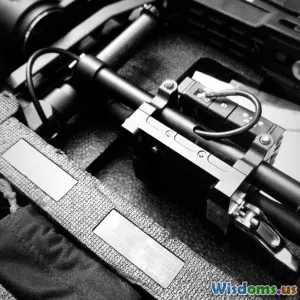
Could Ancient Fire Devices Outperform Modern Grenades
13 min read Explore whether formidable ancient fire devices could match or surpass modern grenades in effectiveness, impact, and ingenuity. (0 Reviews)
Could Ancient Fire Devices Outperform Modern Grenades?
Introduction: Igniting the Imagination
Imagine standing on a storm-battered medieval rampart, hearing the roar of an approaching army, only to witness defenders unleash a torrent of blazing flame that engulfs invaders in terror and chaos. Now, fast-forward to a modern battlefield, where a single pin-pulled grenade hurls shrapnel in every direction. Both scenes showcase humanity’s relentless drive to devise ever more destructive weapons. But a compelling question remains: Could the ingenious fire devices of the ancient world—sometimes shrouded in mystery and myth—have rivaled, or even outperformed, today’s modern grenades?
To answer this, we will journey from the fiery ingenuity of Greek fire to the explosive debut of Byzantine and Chinese hand-thrown bombs, and pit them against the cold logic and calculated lethality of the contemporary fragmentation grenade. Along the way, we’ll scrutinize their technology, real-world effectiveness, and psychological impact. The result isn’t just a tale of arms and armor—it’s a story about human creativity and the shifting balance on the battlefield.
Fire in Antiquity: The Birth of Incendiary Weapons
The Origins of Ancient Fire Devices
Fire, mankind’s earliest and most feared tool, quickly found its place in armed conflict. Early incendiary devices ranged from burning pitch and oil—hurled with simple catapults—to more sophisticated inventions with nearly legendary status.
Greek Fire: The Original Terrifying Incendiary
No discussion of ancient fire weaponry is complete without Greek fire. Developed by the Byzantines in the 7th century CE, Greek fire was notorious for its ability to burn fiercely—even on water. The composition remains a mystery, though ingredients like naphtha, quicklime, resin, and sulfur are suspected. Delivered via siphons and hand-held projectors, Greek fire brought victory to Byzantium during sieges and naval battles with unparalleled psychological impact.
By all historical accounts, when Greek fire hit a ship, its crew faced instant panic—flames would leap from the deck, water offered no salvation, and dousing efforts often made the situation worse.
"The sailors leaped overboard, preferring the depths to the all-consuming fire," chronicled Anna Komnene, the Byzantine historian.
Other Notable Ancient Fire Devices
- Chinese Fire Darts and Bombs: By the 10th century, Chinese military engineers developed oil-filled bombs and fire ‘lances’—the ancestors of grenades and flamethrowers.
- Roman Firepots: Romans used ceramic firebombs filled with burning pitch, sulfur, or quicklime, thrown or launched with catapults.
These devices achieved real results: During sieges, oil-filled jars and fire arrows forced defenders into chaos, burning wooden siege engines and sowing terror.
The Anatomy of Ancient Incendiary Bombs
While exact recipes were guarded state secrets, ancient fire devices generally worked by unleashing a rapidly spreading, persistent flame. Unlike modern explosives, their intent was less to cause sudden, lethal force and more to create terror, confusion, and destruction over a wide area.
For example, a 12th-century Chinese military manual, the Wujing Zongyao, described "thunder crash bombs"—grenade-sized ceramic pots filled with gunpowder and metal fragments, ignited by a fuse and thrown by hand or catapulted, offering a clear precursor to the modern grenade.
The Modern Grenade: Engineering for Instant Lethality
The Evolution from Simple Bombs to Precision Tools
The modern grenade, most commonly the fragmentation ("frag") grenade, is the product of over a millennium of technological refinement. Its core features—an explosive charge surrounded by a casing engineered to fragment—deliver lethal force in all directions.
- Mills Bomb (WWI): Seen as the first modern fragmentation grenade, introduced by the British Army in 1915.
- M67 (Present Day): Current U.S. standard-issue, weighing 400g and producing lethal shrapnel within about 5 meters, with effective injury radius up to 15 meters.
Mechanisms and Effects
Modern grenades marry science and engineering:
- Activation: Simple to use (pull the pin, release the lever, throw), typically with a four to five-second fuse.
- Blast Effect: Detonation sends razor-sharp metal fragments flying at supersonic speeds, incapacitating within a lethal radius.
A well-placed modern frag grenade can clear trenches, rooms, or bunkers within seconds.
Data and Real-World Effectiveness
Standard-issue M67 grenades, according to the U.S. Army Field Manual, have a casualty radius of 15 meters. Their engineered reliability and portability make them indispensable in close-quarters battle, urban warfare, and area denial.
Head-to-Head: Comparing Capabilities
Destructive Power: Flame vs. Explosion
Perhaps the most glaring distinction: ancient fire devices prioritized spreading fire and psychological terror, while modern grenades focus on instantaneous, targeted lethality.
- Greek Fire: Capable of devastating wooden ships and fortifications, could burn on water, and inspired paralyzing fear, but was unpredictable and hard to control.
- M67 Frag Grenade: Delivers a tightly controlled kill radius and almost instantaneous casualty effect, highly reliable under varied environmental conditions.
Range and Handling
Both ancient and modern hand-thrown devices have a spatial similarity: designed for personal use and short-range impact (usually within 30 meters).
- Ancient Devices: Early bombs were often cumbersome. For example, the Chinese ‘zhen tian lei’ (heaven-shaking thunder bomb) required careful handling—made of clay, prone to breakage, and throwing distances varied by user strength.
- Modern Grenades: Compact, uniform, easy to carry (a soldier might carry several), effective ranges usually tested to military standards.
Reliability and Consistency
Ancient fire devices were notoriously fickle. Climate, quality, and secrecy of preparation could render them ineffective or even dangerous to the user. Modern grenades, built in precision factories and subjected to rigorous testing, boast near-perfect reliability.
Psychological Impact: Terror Tactics Across Centuries
Ancient incendiary weapons unleashed primal fear—fire as a destructive force was almost mythic. Survivors’ accounts detail routs and mass panic ignited by the sudden, inextinguishable inferno of Greek fire. In a pre-industrial context, fire wasn’t just destructive—it was apocalyptic.
Modern grenades, though lethal, inspire a different, cold-honed terror: sudden noise, deadly shrapnel, and the knowledge that cover offers little protection. Still, the enduring psychological strategies—destabilizing enemy morale, asserting technological superiority—are echoes of those ancient roots.
The Limits of Ancient Devices in the Modern Era
Adaptability Against Modern Opponents
It’s tempting to romanticize Greek fire or gunpowder bombs as potential "weapons of shock" even today. But context is crucial.
-
Against Modern Armor and Tactics: Ancient incendiaries would fare poorly against steel, composites, and nonflammable synthetic uniforms. Fire-based weapons cannot generate the overpressure or shrapnel lethality required to defeat hard targets or spread terror in modern, mechanized infantry.
-
Portability and Control: Ancient fire devices were ill-suited to rapid movement, discretely operated squads, and the unpredictability of modern combat’s "three-dimensional" urban spaces.
Precision and Safety
Modern grenades incorporate safety features—pins, time fuses, shakeproof detonators—reflecting an awareness evolved over centuries. Ancient fire devices, in contrast, risked catastrophic accidents. A single misstep could lead to premature ignition, endangering the user as much as the enemy.
- According to military historians like Adrian Goldsworthy, Roman defenders sometimes caused secondary blazes within their own lines—one reason why fire-based siege tactics were considered last resorts in major city battles.
The Evolving Battlefield: Lessons from History
While ancient devices were devastating in static siege contexts—where attackers crowded together and wooden structures abounded—today’s mobile, dispersed, and well-equipped troops render incendiary tactics far less effective.
However, some echoes persist. Napalm, molotov cocktails, and white phosphorus continue the tradition of flame-based terror, though all are vastly more devastating than their ancient forebears. Yet, strategically, they are niche: modern doctrine overwhelmingly favors the explosive speed, reliability, and targeted destructiveness of grenades over fire.
Cultural Legacy and Innovation
Fire Devices as Symbols of Ingenuity
Ancient fire weapons aren't just curiosities; they represent pivotal advances in chemistry, engineering, and psychological warfare. They shaped empires—Greek fire was credited with saving Byzantium from several otherwise catastrophic invasions.
Their mystique lingers in popular culture—appearing in video games, novels, and movies as fearsome, almost magic, superweapons.
Lessons for Modern Weapons Designers
Several design lessons endure from the ancient world:
- Unpredictable Threats Create Psychological Warfare: The psychological effect can devastate morale and cohesion, often more than physical destruction.
- Adaptability Wins Battles: Byzantine innovators constantly revised Greek fire systems, much as modern militaries iterate grenade design for changing threats.
- Secrecy and Reputation Magnify Effects: Greek fire was legendary in part because its recipe was never fully disseminated—a crucial deterrence principle that echoes in classified modern weapon systems.
Conclusion: Is the Ancient Arsenal Obsolete?
The comparison between ancient fire devices and modern grenades is a testament to the relentless forward march of military science—and the persistent shadows of our fiery past. On one hand, ancient incendiaries like Greek fire and early gunpowder bombs were shock weapons of their age: sapient, unpredictable, and terrifying. Their real lethality lay not just in physical destruction, but in the psychological defeat of their enemies.
Yet, placed on the scales of modern warfare, their failings become clear: lack of portability, reliability, and sheer destructive precision. They couldn’t punch through kevlar, hulls, or the scattered deployment of modern infantry. Modern grenades, by contrast, are tailored for today's combat: lethal, portable, precise, and supremely reliable, their effectiveness underpinned by generations of research, testing, and combat feedback.
From ancient ramparts to urban skirmishes, both weapons strove for battlefield advantage—but technology and tactical demands have set clear boundaries. As much as fire-and-fear captured the medieval imagination, today’s battlefield demands the cold, clinical efficiency of explosive grenades.
In summary: Ancient fire devices are brilliant artifacts of their time, sculpted by necessity and ingenuity. But in a direct contest with modern grenades, they would flicker—spectacularly, hauntingly, but ultimately briefly—before being overtaken by the precision and devastating effectiveness of 20th- and 21st-century ordnance.
Reflect, Imagine, Innovate
Yet perhaps the greatest legacy of the ancients is inspiration. Let their ingenuity remind us: Even the fiercest weapon begins as a clever idea. Who knows what incendiary inventions the next millennium will ignite?
Rate the Post
User Reviews
Other posts in Military History
Popular Posts















